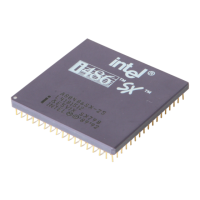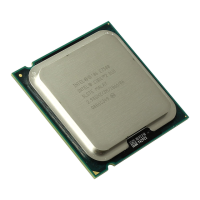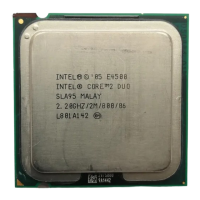EMBEDDED Intel486™ PROCESSOR HARDWARE REFERENCE MANUAL
Index-2
C
Cache
see also Level-1 cache or Second-level cache
4-way set associative,
6-9
block size, 6-10
broadcasting, 6-14
configuration options, 3-13
consistency, 4-52, 6-13, 7-28
defined, 6-1
direct mapped, 6-6
effect on bus cycles, 9-6
external
see Second-level cache
fully associative,
6-5
hardware transparency, 6-14
hit rates (L1), 6-3, 9-6
invalidating lines, 3-12
memory hierarchy and, 6-19
memory mapped I/O devices, 7-27
multi-processor systems, 6-16
non-cacheable regions, 3-12
on-chip, 2-6, 3-4, 7-28, 9-4
organization on-chip, 3-11, 9-4
performance issues, 6-2 to 6-5, 9-4
replacement, 3-12, 6-11
sector buffering, 6-9
set associative, 6-8
single vs. multiple processor systems, 6-16
structure, 3-10
two-way set associative, 6-8
updating, 3-12
updating main memory, 6-11
write-back, 3-12, 6-13
write-through, 3-12, 6-12
Cache enable (KEN#) signal, 5-2 to 5-4
Cache transparency, 6-16
Cache unit, 3-10
Cacheable cycles, 4-21, 5-2 to 5-4
Chapter summaries, 1-1
Chip capacitors, decoupling, 10-8
CHMOS IV process, 10-1
Clear, defined, 1-4
Clock (CLK) signal
skew,
10-30
Clock considerations, 10-30 to 10-32
Clock routing, 10-32
Clock timings, 10-31
Control registers
debug,
10-42
Control unit, 3-14
Controllers, embedded, 2-12
Cross-talk, 10-25
Customer service, 1-5
D
Daisy chaining, 10-24
Data access rate, 5-1
Data buffers, 7-32
Data bus
dynamic bus sizing,
2-1, 4-3
Data transceivers, 7-26
Data transfer, 3-8, 4-1
Datapath unit, 3-14
Deassert, defined, 1-4
Debug control register, 10-42
Debug registers, 10-39 to 10-41
Debugging, 10-37, 10-43
features of the Intel486 processor, 10-39
Decoupling capacitors, 10-6
Derating curve, 10-36
Direct mapped cache, 6-6
DMA
cache and,
6-16
in multiple processor system, 4-14 to 4-15
in single processor system, 4-12 to 4-13
DMA controller
82420EX PCIset,
8-33
in EISA designs, 8-16
Documents, related, 1-6
DOS address, defined, 1-4
DRAM
clock latencies,
5-6
design, 9-14
interleaving, 9-14
Dynamic data bus sizing, 2-1, 4-3, 7-3

